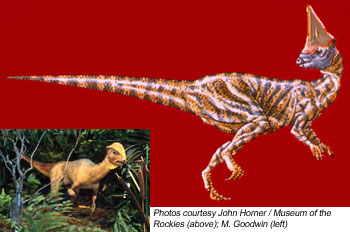Geotimes

Web Extra
Tuesday, June 15, 2004
Domed dinos made love not
war
 In the 1950s,
paleontologists hypothesized that dinosaurs with skulls shaped like bowling
balls butted heads, much like sheep or other modern horned animals might. Called
"battering rams" by one researcher, dome-headed dinosaurs may have
head-butted to compete for territory or mates, an idea that was further popularized
in a science-fiction story at the time. But a recent reassessment of some of
these fossils revealed something quite different: that the spherical skulls
could be divided by age instead of gender, calling into question these animals'
presumed habits.
In the 1950s,
paleontologists hypothesized that dinosaurs with skulls shaped like bowling
balls butted heads, much like sheep or other modern horned animals might. Called
"battering rams" by one researcher, dome-headed dinosaurs may have
head-butted to compete for territory or mates, an idea that was further popularized
in a science-fiction story at the time. But a recent reassessment of some of
these fossils revealed something quite different: that the spherical skulls
could be divided by age instead of gender, calling into question these animals'
presumed habits.
Pachycephalosaurs may or may not have butted heads with each other, depending
on what their skeletons say.
The rounded heads, radiating bone structures and the spongy bone composition in
the skulls of animals called pachycephalosaurs fueled speculation about their
lifestyle. However, in an analysis of a group of skulls collected in Montana containing
different species of pachycephalosaurs, Mark Goodwin of the University of California
Museum of Paleontology in Berkeley and Jack Horner of the Museum of the Rockies
at Montana State University in Bozeman showed that younger pachycephalosaurs had
the bulging crania with spongy inner skulls and radiating bone structures, but
adults did not.
"We have a growth series," Goodwin says. "We're able to show
that they're gone — the structures are absent in adults." Using high-resolution
scans of thin sections, the researchers also can show bone sutures and where
the adults' brains made contact with the skulls — but no cushioning cavity
that is generally present in modern head-butting animals.
Instead, write Goodwin and Horner in the spring issue of Paleobiology,
the older specimens from the community had a thick layer of tiny mineralized collagen
fibers, called Sharpey's fibers. The fibers tend to anchor skin coverings or other
kinds of integument of modern animals, such as the beaks of toucans. So rather
than butting heads, the authors hypothesize, pachycephalosaurs had head structures
with coverings that were used for other kinds of displays, identifying them to
their own species mates or reflecting light through attached horn material (to
potential mates in presumably attractive ways) to signal their sexual identity
or maturity.
The lightness of the vertebrae and the rest of the adults' skeletons, Goodwin
says, also indicate that the creatures may not have been able to survive an
impact from a head butt. "Bone is a dynamic tissue and remodels itself
in response to stress," he says. "We didn't see any evidence of increased
remodeling" in the skulls or hind legs of several skeletons previously
examined that would indicate a response to impacts.
"I'm not absolutely convinced," says Peter Galton, a paleobiologist
at the University of Bridgeport in Connecticut, who helped to establish the
pachycephalosaurs' "battering ram" image in his work in the 1970s.
Galton says that the work is useful, particularly in showing that the radiating
bone structures are actually age-related characteristics. Nevertheless, he says,
"there are a lot of other features used to argue for head bouncing or flank
butting. Those are not really addressed."
Galton says that other characteristics "don't make sense if they are just
a display structure," such as shortening of the head case. He also points
out that the back of the skulls of pachycephalosaurid dinosaurs would serve as
"a large plate for the attachment of enlarged neck muscles," and that
the vertebrae and hip joints are well-placed to withstand impacts, in both males
and females.
Nonetheless, Galton says, a range of behaviors may have been possible, including
the use of dome and horns for display only. And, he says, collisions "head-on
may be a little extreme."
Naomi Lubick
Back to top


 In the 1950s,
paleontologists hypothesized that dinosaurs with skulls shaped like bowling
balls butted heads, much like sheep or other modern horned animals might. Called
"battering rams" by one researcher, dome-headed dinosaurs may have
head-butted to compete for territory or mates, an idea that was further popularized
in a science-fiction story at the time. But a recent reassessment of some of
these fossils revealed something quite different: that the spherical skulls
could be divided by age instead of gender, calling into question these animals'
presumed habits.
In the 1950s,
paleontologists hypothesized that dinosaurs with skulls shaped like bowling
balls butted heads, much like sheep or other modern horned animals might. Called
"battering rams" by one researcher, dome-headed dinosaurs may have
head-butted to compete for territory or mates, an idea that was further popularized
in a science-fiction story at the time. But a recent reassessment of some of
these fossils revealed something quite different: that the spherical skulls
could be divided by age instead of gender, calling into question these animals'
presumed habits. 